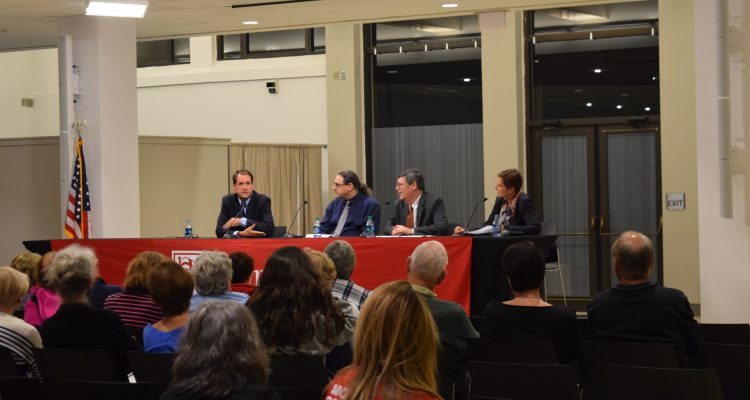The problem of gun violence in America is often conceptualized in terms of assault rifles and mass shootings, not the violence some communities face daily. In the John A. Barone Campus Center Oak Room on Sept. 20, three panelists sought to discuss gun violence as a broader American problem.
“Gun Violence as Public Health Crisis” was moderated by Melissa Quan, director for the Center for Faith & Public Life. The three panelists were Dr. Patrick Kelley, distinguished visiting fellow in the Marion Peckham Egan School of Nursing and Health Studies, Dr. Bradley Stolbach, associate professor of pediatrics at the University of Chicago and clinical director of Healing Hurt People and Congressman Jim Himes, United States Representative for Connecticut’s Fourth District (D- Conn.) In addition to his position at Fairfield University, Kelley is the founder of the Forum on Global Violence Prevention at the National Academies of Science.
In attendance at this event were Fairfield University students as well as community members, including members of the non-profit anti-gun violence organization Moms Demand Action for Gun Sense in America wearing bright red shirts with their logo. One of the women from Moms Demand Action brought a baby with her, who squeaked from its carrier as the panelists discussed gun violence.
While some seats toward the front of the Oak Room were left empty, many students sat on benches or on the floor at the back of the room. Senior Annie Kamradt, Fall intern for the Fairfield University Art Museum, reported that the Oak Room was at its capacity of 400 people.
The event was a first-year experience thrive event.
“This event was different than other #UNLOAD events because it focused on a new facet of the ‘gun debate.’ I had never considered gun violence to be a public health crisis until I heard about this panel,” said Kamradt.
Quan had the three speakers introduce themselves and their perspectives in five to eight minutes, and then asked them questions she had prepared and questions from the audience.
Kelley explained gun violence as a public health issue, and pointed out that nearly two thirds of gun deaths come from suicides. Kelley quoted journalist Stephen Lurie to say that, “Where we worry the most, we can help the least, and where we could help most, we care the least.” By this he explained that he meant that gun deaths by suicide or in urban areas, for example, are more predictable and preventable than mass shootings — but no one seems to care.
In Chicago, Stolbach works on helping what he described as, “Interpersonal and identity-based violence that’s happening in racially and economically segregated communities.” The organization he is a clinical director for, Healing Hurt People, seeks to help children impacted by gun violence — some of whom may have participated in violence themselves — with the psychological injuries they carry forward with them.
First-year Zola Bernardi reflected on Stolbach’s contributions to the discussion. “Learning about the statistics of children that are grown up and exposed to gun violence is truly sad,” Bernardi said.
Himes, who pointed out that he was the only panelist who did not have a doctorate, spoke on gun violence from the perspective of public policy. He explained that the 1996 Dickey Amendment, which bars the Centers for Disease Control and Prevention from using research to advocate for gun control, has often been used to block any research on gun control again.
Because of this, Himes said, “We’re not even to the point where we can get to good answers.”
All three of the panelists, throughout the event, focused on the need for research. Stolbach particularly focused on the issue of the lack of research where Chicago is concerned, saying that, “Part of our public health approach has to be: ‘who’s putting guns in the hands of children?’” because many of the guns that end up in Chicago are illegal – and without research, they cannot find out where they come from.
Senior Katherine Reilly stated, “Hearing the perspectives of three different individuals with different backgrounds was extremely helpful. My first year at Fairfield I did a research project on gun violence in the U.S. This topic is something I am extremely passionate about.”
Himes, on the gun control debate, said, “It’s better to be persuasive than to be right.” He said that the argument, in Congress and around the country, gets bogged down in the matter of ‘pro gun’ vs. ‘anti gun’ — and when that is the extent of the conversation, constructive policy changes cannot happen.
“Hearing that the gun violence issue should not be addressed as ‘pro’ or ‘anti’ really changed my perspective,” said Jimmy Folks ‘22.
“Gun Violence as Public Health Crisis” was part of the series of events planned around “#UNLOAD: Guns in the Hands of Artists”, the exhibit currently on display in the Fairfield University Art Museum’s Walsh Gallery. Other events planned around #UNLOAD include the Sept. 12 panel discussion “Gun Violence in Connecticut: Realities and Paths Forward” and a Sept. 25 talk by artist Bradley McCallum regarding the transformation of guns into art.


Leave a Reply